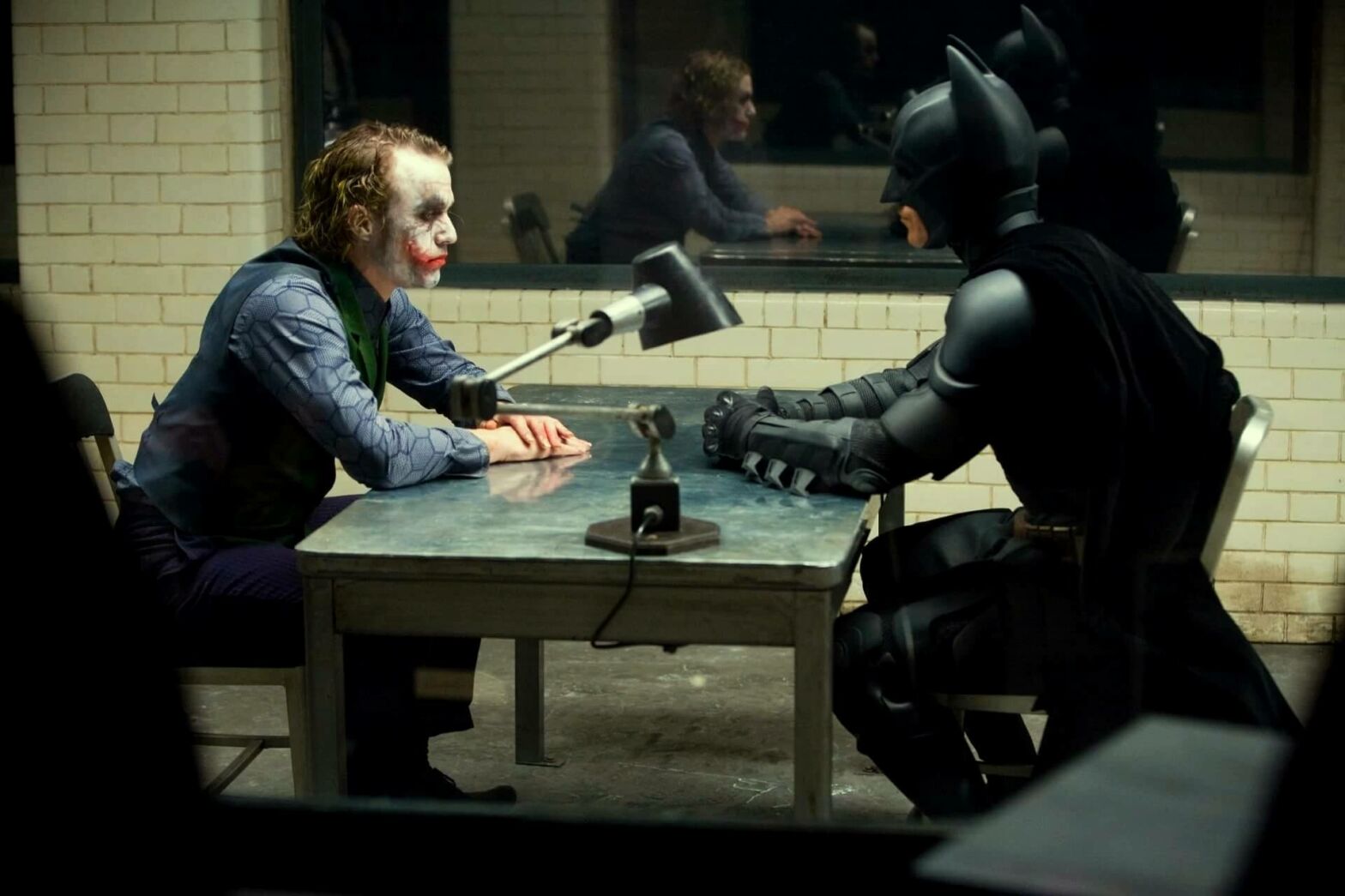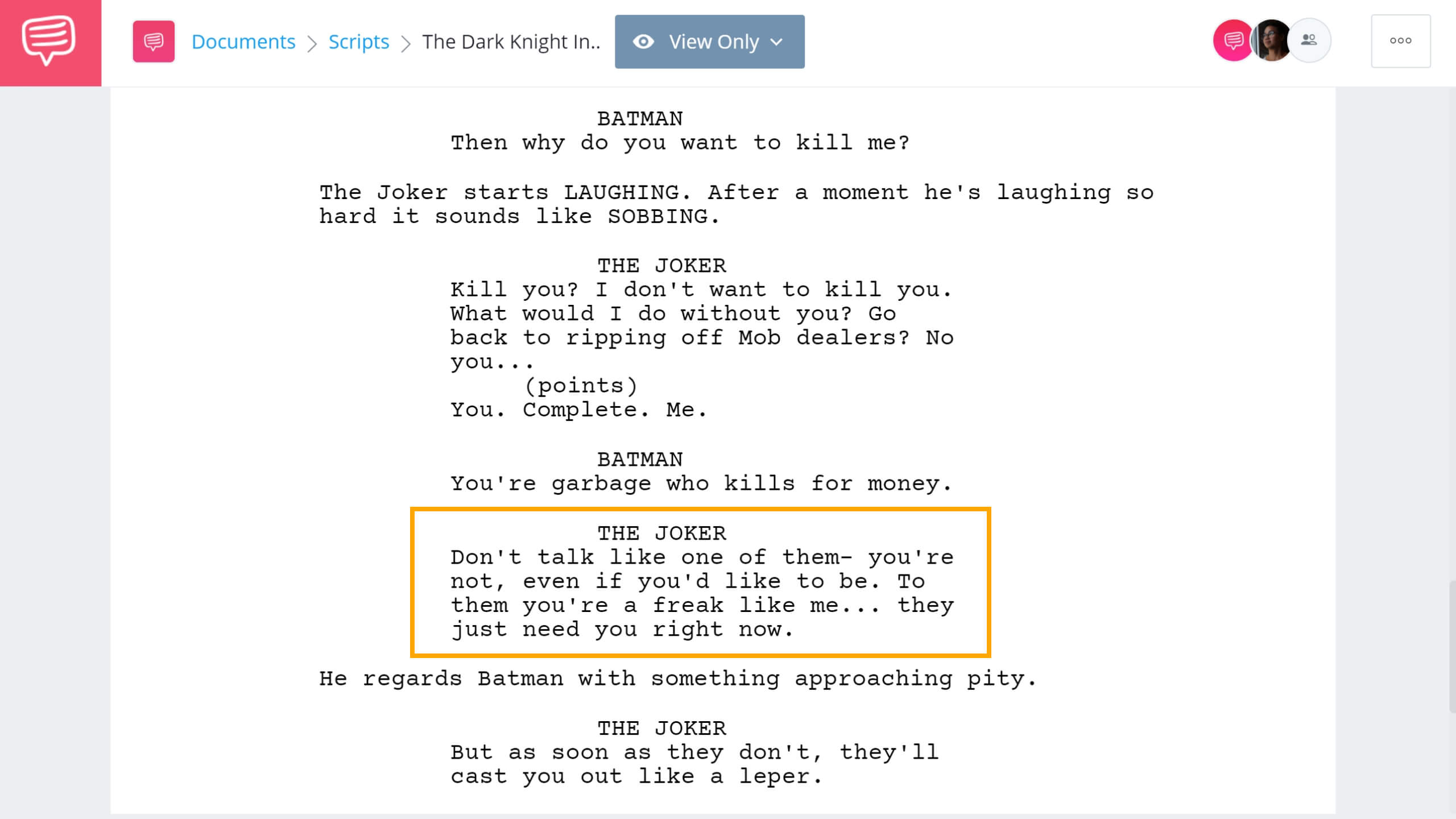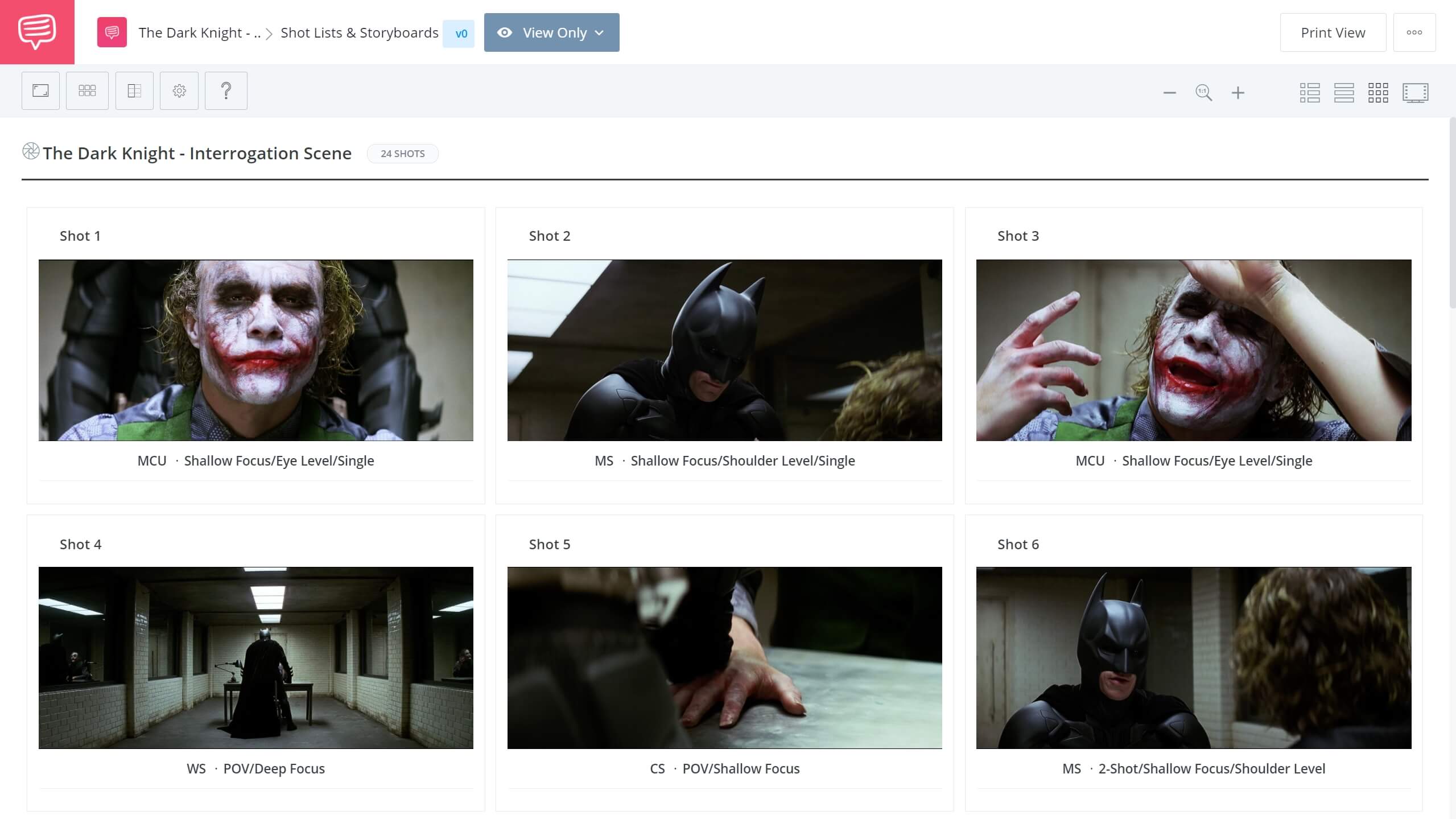Detective movies love a good interrogation scene. It’s when the protagonist finally meets her foe, sitting across from him in a small room with nothing to do but talk. For filmmakers, these scenes are a dramatic goldmine, allowing them to dig into the psyche of their two leads while also revealing key plot details. At the same time, however, it can be difficult to keep these scenes engaging. Two people sitting and talking is not the most cinematic scenario. In this post, we’ll dissect one of the most iconic scenes in cinema history: The Dark Knight interrogation scene. By examining the sequence’s writing, direction, editing and score, we’ll understand why it’s such a great example. Let’s jump in.
The Dark Knight Interrogation Scene
Interrogating the Joker
The Batman-Joker interrogation scene happens a little over halfway into The Dark Knight, and functions as a midpoint turn for the film. It’s the first opportunity Batman gets to have an extended conversation with the Joker.
Therefore it is also the first time the audience gets to see them interact on a deeper level. If you haven't watched The Dark Knight interrogation scene lately, here it is to refresh your memory.
The Dark Knight interrogation scene in all its glory
At first, however, we don’t realize this is the case. The Dark Knight interrogation scene begins as a conversation between the Joker and Commissioner Gordon. Gordon reveals that Harvey Dent “never made it home,” a fact which Joker does not seem surprised by.
Gordon accuses the Joker of being behind Dent’s kidnapping (safe assumption here, Gordo) before leaving to get some coffee.
Lo and behold, Batman has been standing behind the Joker the whole time, and he takes Gordon’s exit as an opportunity to introduce Joker’s forehead to the table. This is where the real meat of the scene gets grilling. Joker is in a mood for games, and Batman is not: the eternal conflict.
Joker toys with Batman as our hero gets more and more frustrated. Finally, Batman bars the door and begins to pulverize the Joker, who only gets off to such brutalization.
Finally, Mr. Joker sputters out the addresses of Dent and Batman’s sweetheart Rachel. With that, The Dark Knight interrogation scene concludes.
The sequence is fairly straightforward — reminiscent of interrogation scenes we’ve seen millions of times — and yet it is riveting from beginning to end. What makes this showdown stand out?
The Dark Knight Interrogation Scene
Write with intimacy
The first lesson to take away from the Joker interrogation scene is within the scene’s writing. Christopher Nolan and Jonathan Nolan, The Dark Knight’s writers, take full advantage of the intimacy of an interrogation.
In other words, they use this isolated and contained interaction between their protagonist and antagonist to flush out each character’s mentality and to illustrate why they are such a perfect match up.
Let’s take a look at a particular exchange in The Dark Knight Joker interrogation scene script, which we imported into StudioBinder’s screenwriting software. Click the script below to download a PDF of the scene. You can also download The Dark Knight script and read our complete analysis.
Pay attention to how Joker attempts to create a bond between himself and Batman — they are alike, more than Batman is willing to admit.
Read the entire Batman interrogation scene
This back and forth encapsulates the magic of Batman and Joker’s dynamic, why we keep going back to this pair over and over and over again. Joker says it explicitly: “You. Complete. Me.”
Joker sees himself in Batman, and why shouldn’t he? Both find themselves as outsiders to their respective sides of crime and justice. The Joker is a criminal who disrupts Gotham's crime bosses just as much as the police. And Batman is a vigilante who operates outside the parameters of Gotham's finest.
Joker is compelling because he understands this dynamic. Take this line: “To them you're a freak like me... they just need you right now.” This is absolutely correct — the audience understands it and Batman understands it.
And it drives him crazy.
We can also look at Joker’s final lines in this snippet: “Their morals, their code... it's a bad joke. Dropped at the first sign of trouble. They're only as good as the world allows them to be […] when the chips are down, these civilized people... they'll eat each other.”
This is exactly what Batman believes. If Bruce Wayne truly believed in municipal government’s morals and codes, he would have joined the police department. If he believed in civilized people, he wouldn’t be slapping on the spandex every night to hit them in the face.
Thus, we have a scene where Batman is trying to outmaneuver his own reflection, an impossible feat. And so he loses. He’s beating the Joker up, but he’s losing. The Joker only gives him the addresses because he wants to.
This type of psychoanalytic conversation would be impossible outside the confines of an interrogation room. The interrogation setting strips away any variables which could enter the scene: here, it’s just the Batman and the Joker, having it out.
Related Posts
The Dark Knight Interrogation Scene
Understand the power dynamic
The key to a great interrogation scene is an intricate understanding of the power dynamic between the interrogator and the detainee.
The very nature of the interrogation scene lends an upper hand to the interrogator. This is their turf, they’re in control of the environment, their detainee is in handcuffs and they’re not.
But, more often than not, filmmakers choose to subvert this inherent power dynamic. Thus lending the upper hand (or at least some leverage) to the detainee. In the Joker interrogation scene, the Nolans choose this option.
As the Joker notes, “You have nothing. Nothing to threaten me with. Nothing to do with all your strength.” Once more, he’s correct.
Batman’s main power is brute force, and as the scene progresses, it’s clear this force has no effect on the Joker.
This dynamic is relatively obvious (as the Joker spells it out explicitly), and so Christopher Nolan chooses to shoot the scene in a way which subverts this dynamic. Take a look at the shots that comprise the scene, which we placed in StudioBinder's storyboard software:
The camera positioning lends the power to Batman. If we were to look at this shot reverse shot out of context, we would assume Batman is the one in control:
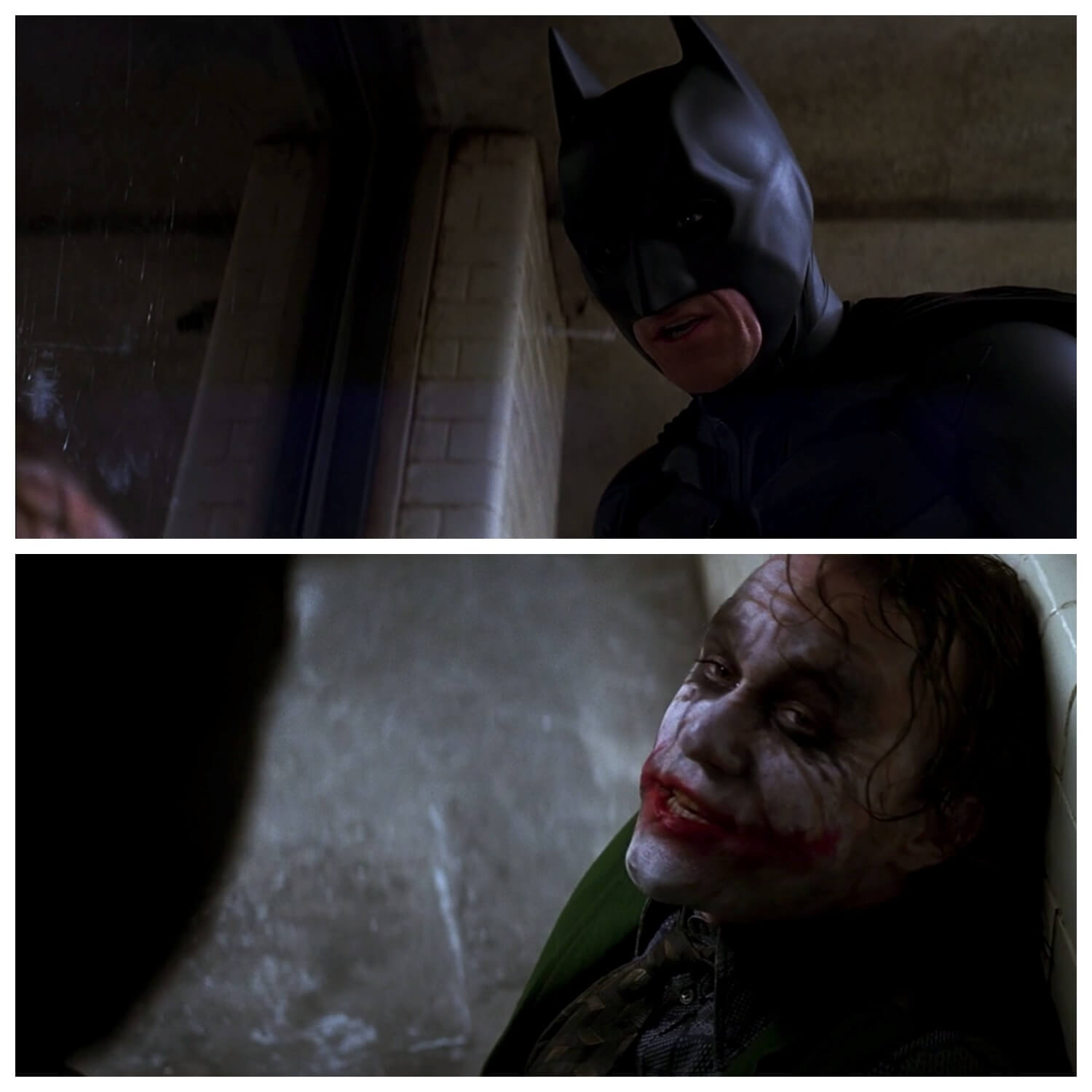
Two pals, having a catch up • Batman interrogation scene
The low angle on Batman imbues him with power, looming over the audience. Conversely, the high angle on the Joker is diminutive — we’re looking down at him. These cinematography choices seem to undermine the power dynamic we understand, creating a visual tension.
But in the Dark Knight interrogation scene, of course, tension is good.
And by misrepresenting the power dynamic visually, Nolan is emphasizing Joker’s cockroach-like resilience. None of Batman’s traditional power is effective on him. This makes Joker even more terrifying — he’s in a position where he couldn’t have less power, and yet he’s still in control.
Nolan is so confident in this power dynamic that he even cuts to Gordon during their showdown and has him say of Batman, “He’s in control.” No one in the audience believes this.
The Dark Knight Interrogation Scene
Pace with intention
It is crucial for an interrogation scene to have purposeful pacing. If a filmmaker doesn’t have a firm command of the pacing of the scene, a tense conversation can be instantly deflated.
Once more, we can look to the Batman/Joker interrogation scene for a shining example of pacing.
The interaction begins with a bang — the bang of Joker’s head against a metal slab — but then quickly settles to a simmer. Editor Lee Smith opts for longer takes as Joker waxes poetic.
This has two purposes. Slow cutting helps build tension; if Smith was cutting rapidly between Batman and Joker, any tension would be out the window. And secondly, Heath Ledger is giving an incredible performance, so it’s best to let it breathe.
Ledger is so terrifying, just sitting on a close up of his face is enough to give the audience chills (for our money, Ledger is the best live action Joker ever).
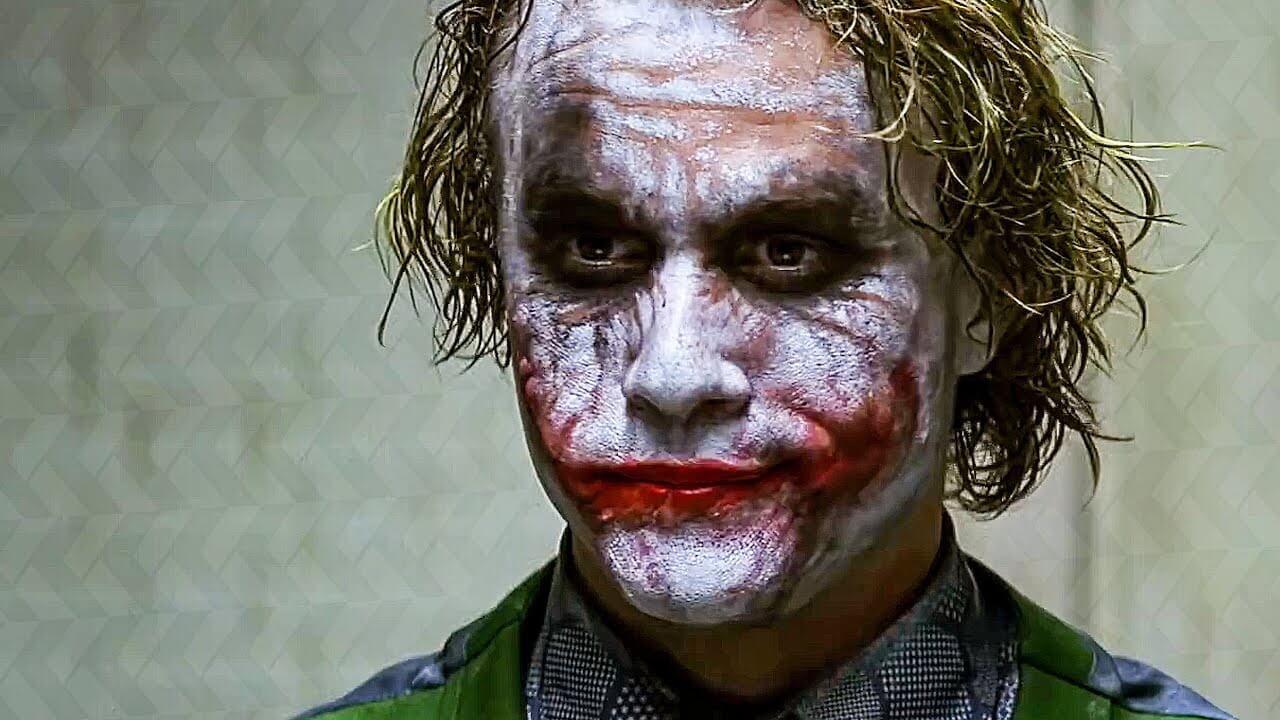
Batman Joker interrogation
Then, Joker strikes a nerve, when he finishes his monologue we dissected in script form. The cuts speed up as Batman loses his patience and grabs his foe by his collar. This rapid cutting indicates Batman’s increasingly frantic internality, and it’s this rapidity that makes the subsequent “he’s in control” line so laughable.
Batman’s loss of composure is paired with a dissonant drone of strings, the first piece of scoring in the scene. Adding music further emphasizes the rising urgency of the scene, and since this is Joker’s theme, it also indicates that Joker is prevailing.
Nolan uses all elements of film form in order to make this interrogation scene not just an echo of other interrogation scenes, but a mastery of them.
UP NEXT
Download The Dark Knight script
The Dark Knight interrogation scene is a magnetic and thrilling scene, both on paper and on screen. And it's just the beginning of how well the script was written by the Nolan brothers. Next up, read our analysis of the entire script and download a PDF of the screenplay while you're at it.
Up Next: The Dark Knight Script →
Showcase your vision with elegant shot lists and storyboards.
Create robust and customizable shot lists. Upload images to make storyboards and slideshows.
